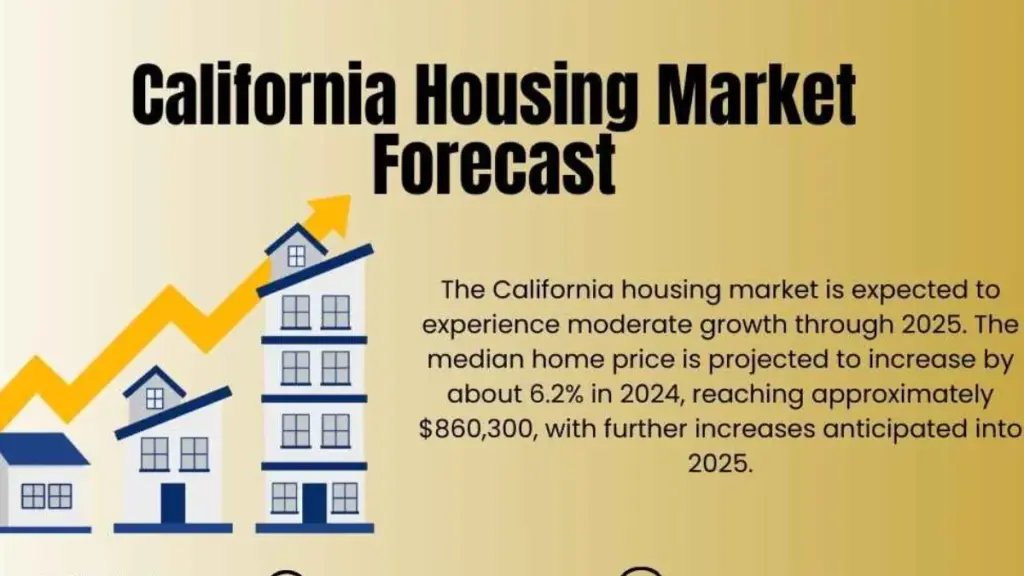California housing market has always been one of the most closely watched in the United States. Known for its high property values, limited supply, and diverse regional differences, California remains a challenging yet desirable location for homebuyers. As of 2025, the market is at a crossroads, with modest price increases, slightly improved inventory, and new policies designed to boost housing development. However, affordability challenges and investor influence continue to create hurdles for typical buyers.
This detailed guide explores the current state of the California housing market in 2025, covering price trends, sales volume, inventory levels, and the impact of new housing policies. It also highlights what buyers should know and how they can navigate this competitive market.
Current Market Overview
Rising Median Home Prices
In mid‑2025, California’s median home price has reached approximately $865,000–$870,000, reflecting a modest year-over-year increase of about 1%. While the growth rate is slower than in previous years, the state continues to rank among the most expensive in the country. In the Bay Area, median prices are well above $1.2 million, making affordability a persistent challenge.
Sales Volume and Inventory
Home sales have slightly increased compared to the previous year, while inventory levels are gradually improving. The California Association of Realtors projects existing single-family home sales to total over 300,000 units in 2025, up more than 10% from 2024.
However, the “lock-in effect” continues to restrict supply. Many homeowners are reluctant to sell because they secured historically low mortgage rates in prior years. As a result, even with higher buyer demand, the number of new listings remains limited.
Affordability Issues
Despite slight improvements in inventory, affordability remains a major obstacle. With mortgage rates averaging between 6.5% and 7%, buyers face higher monthly payments. Combined with already high home prices, this creates a barrier for many, especially first-time buyers.
Regional Differences in California
The state’s housing market varies greatly by region:
- Bay Area: Still the most expensive, with median prices exceeding $1.2 million in many counties.
- Southern California: Popular coastal areas like Los Angeles, Orange County, and San Diego remain pricey, but some inland regions offer more affordable options.
- Central Valley: Cities like Fresno and Bakersfield provide more budget-friendly housing compared to coastal metros.
- Northern California Counties: Areas like Sacramento and San Benito are seeing growth in new construction and slightly lower prices.
The Role of New Construction
Increased Development in Inland Counties
Counties such as San Benito and Alameda are leading in new housing development, with construction growth exceeding 9% in some areas between 2020 and 2025. Inland areas are becoming attractive due to lower land costs and fewer zoning restrictions.
New Homes vs. Existing Homes
Interestingly, new homes in California are often $150K–$200K cheaper than existing homes. This price gap makes newly built homes more attractive for buyers seeking affordability.
Policy Changes Affecting Housing
Assembly Bill 130 (AB 130)
Signed in June 2025, AB 130 exempts many infill housing projects from lengthy environmental review processes, aiming to speed up housing approvals.
Senate Bill 131 (SB 131)
This bill further streamlines approvals for infrastructure and mitigation projects, helping developers overcome some bureaucratic delays.
Expected Impact
These policy changes are designed to encourage faster construction and greater housing supply. While the effects may take time to be fully realized, they represent a significant step toward easing California’s housing crisis.
Investor Influence on the Market
A growing concern in the California housing market is the rise of investor-owned properties. Nearly 19% of homes are now owned by investors, and in some rural counties, investor ownership can reach as high as 83%.
This trend limits the availability of homes for first-time buyers and families, as investors often purchase properties in cash, outbidding typical buyers. It also contributes to rising rental costs, as investor-owned homes are frequently converted to rental properties.
Environmental and Economic Challenges
Groundwater Depletion Impact
In California’s Central Valley, groundwater overuse has led to land subsidence, which has in turn lowered property values by up to 5%. The cumulative loss in home value across the region exceeds $1.8 billion, underscoring the impact of environmental issues on housing markets.
Climate Risks and Insurance Costs
Wildfire risks and rising insurance premiums are additional concerns for homeowners in California. In high-risk areas, insurance costs can be significantly higher, affecting overall affordability.
What Buyers Should Know in 2025
- Explore New Construction Homes: They are more affordable than existing homes and often come with modern energy-efficient features.
- Consider Inland Areas: Locations like Fresno, San Benito, and Sacramento offer better affordability compared to coastal metros.
- Understand Mortgage Rates: While rates remain high, experts predict a gradual decline over the next few years, which could improve affordability.
- Be Prepared for Competition: With limited supply and strong demand, buyers should be financially prepared to act quickly.
- Watch for Policy-Driven Changes: New laws may lead to an increase in available housing, creating better opportunities in the coming years.
Conclusion
The California housing market in 2025 is characterized by modest price growth, slightly improved inventory, and new policies aimed at increasing housing supply. However, affordability remains a challenge due to high prices, elevated mortgage rates, and growing investor activity.
For buyers, exploring new construction and inland regions may offer better opportunities, while sellers can benefit from steady demand in a competitive market. Over time, legislative reforms and increased construction may help balance supply and demand, gradually improving affordability.
FAQs
1. Are California home prices expected to drop in 2025?
Prices are unlikely to fall significantly due to strong demand and limited housing supply. However, growth may remain modest.
2. Is now a good time to buy a home in California?
Yes, especially for those looking at new construction or more affordable inland regions. However, buyers should be prepared for high mortgage rates.
3. Which areas are most affordable in California?
Inland counties like Fresno, Bakersfield, and San Benito offer more budget-friendly options compared to coastal areas like Los Angeles and San Francisco.
4. How are new housing policies helping buyers?
Policies such as AB 130 and SB 131 aim to accelerate the approval of new housing developments, which could lead to increased supply and improved affordability in the future.
5. Are mortgage rates expected to fall soon?
Mortgage rates may gradually decline over the next few years, potentially improving affordability for buyers.



